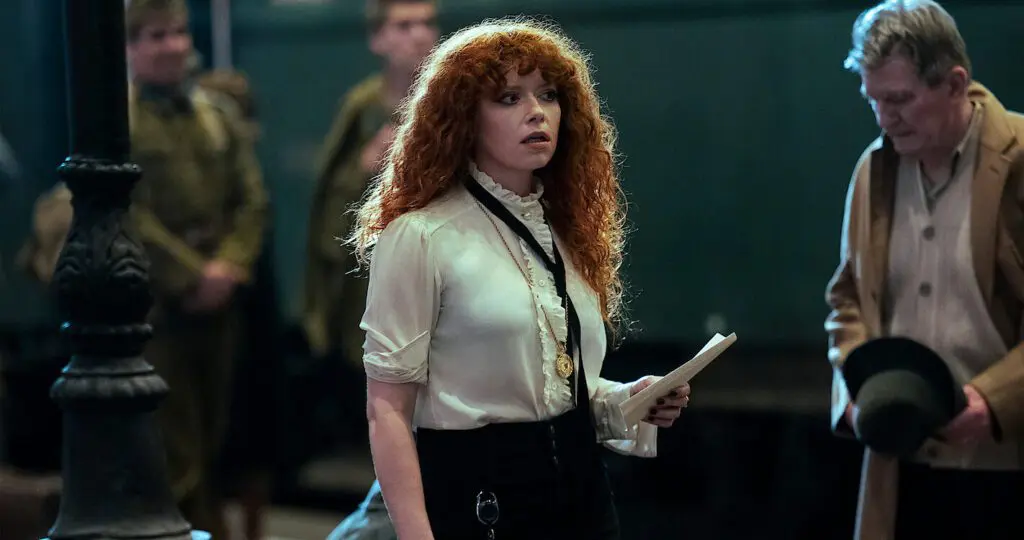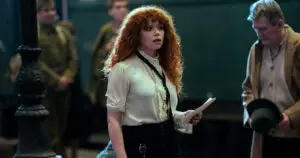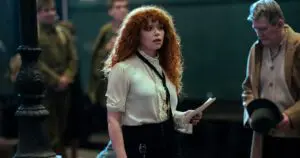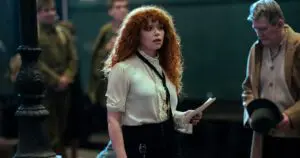This article, “How does the time travelling train work” contains spoilers regarding Netflix’s Russian Doll season 2.
Access the archive of recaps, reviews, and news for Russian Doll.
The concept of season one was a time loop. Nadia and Alan were both caught in the same time loop, either ending the day by going to sleep or dying in horrific fashion. Either way, they always ended up back at the same starting point. As the show evolved time became more unstable, with natural objects (fruit, flowers etc.) decaying and then eventually people starting to disappear too. To stop the infinite loop, they had to rewrite their wrongs and care for one another, merging the time lines in the finale. It was a morality tale wrapped up in a gimmicky concept. Season two is exactly the same, but with a different spin on time.
Season two’s concept is time travel, with a bit of body hopping thrown in for good measure. Nadia ventures on the New York six train and ends up in 1982, inhabiting the body of her pregnant mother Lenora. Whereas Alan journeys back into 1962 East Berlin, within the body of his grandmother Agnes. As the series progresses Nadia and Alan tackle other eras in different bodies as time eventually collapses and breaks down completely. But how does this time travelling train exactly work?
Russian Doll season 2 – how does the time travelling train work?
If we start with Nadia, one of her major issues, probably seen more as a curse, is the stolen Krugerrands. Her family is plagued with misfortune and she wears this bad luck with pride. The one remaining gold coin is forever in her thoughts, always worn around her neck. Old Chez calls the story a ‘Coney Island’, an ‘if only’ scenario. The one thing that could have solved all her life’s worries. This curse weighs heavily on Nadia’s mind. It is as if the train purposely transports her to the one moment where this curse takes form, leading her to tackle the issue head on.
Nadia finds herself in 1982 New York on the very night that Lenora and Chez steal the Krugerrands. Is this another morality tale? Does Nadia have to stop her mother from stealing the coins to rewrite history? Well she doesn’t, in fact Nadia helps Chez in stealing the Krugerrands. When she realises what has actually transpired, the software engineer tries to resolve the issue. Firstly by buying the coins back, which as you will be aware only ends in further disaster. The second time Nadia must travel back to the forties.
Again, the train purposely deposits Nadia in the right place and time. In 1944 Budapest, Nadia retrieves the family heirlooms and makes sure Vera will be reunited with them in a safer future. Maybe whatever Nadia’s mind desires comes true or it’s just a satisfying narrative device to highlight the most prominent parts of the family’s history.
With time collapsing due to Nadia’s foolish choices, the train starts to act erratically. We’re thrown through numerous time periods and the train is home to characters from multiple eras all at once. In one trippy scene Nadia walks through the train and finds each carriage is a different era, looping back to the start. As Nadia’s brain tries to take in all the latest details and revelations, she travels from one period to another.
Russian Doll can be a complex show at the best of times, but the time travelling antics only muddies the water further. Both Nadia and Alan appear to be on a second existential outing here, where they discover the true meaning of life via a time-related paradox. In the end they both see the importance of family and friends. Nadia respects her mother and grandmother more from the time travelling. Whilst Alan learns to live a little and not to worry about making mistakes so much. It’s another virtuous discovery thanks to a time-related concept, which just so happens to be a time travelling train this season.




